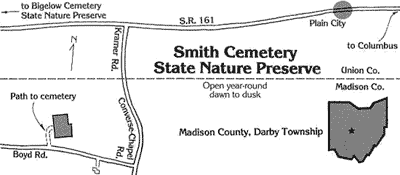

Northern Madison County and southern Union County are the flattest, table-top smooth area of Central Ohio. Historians note, however, that this rich agricultural land was among the last areas to be settled. The pioneers found it to be an extensive tallgrass prairie with poorly drained soil and scattered groves of bur oaks.
In the middle of a corn field along a Madison County road about 30 miles west of Columbus, Karen and I visited a remnant of this natural history – Bigelow Cemetery State Nature Preserve. Four ancient bur oak trees rise above the corn to mark this half-acre pioneer burial ground. What makes this spot special is that the prairie sod was never plowed, and it has become one of the last places in central Ohio where the plants of the prairie flourish. We waded through shoulder-high grasses with patches of purple coneflower and clumps of big bluestem stretching above our heads.
The cemetery is located in the Virginia Military Lands, a district set aside for veterans of the Revolutionary War in payment for their services. A decade after Ohio became a state in 1803, settlers largely from Pennsylvania and New England began to move into the Darby Plains.
The earliest burials in Bigelow Cemetery were in 1814. The last known burial was in 1892. Narrow paths through the grass led us by the tombstones of infants, children and middle-age adults. Yet one hardy woman lived to be 93. A man is buried beside two wives who died before him. A child by his third wife is nearby, but we couldn't find a marker for her. Perhaps, she remarried and changed her name. The cemetery became a state nature preserve in 1978.
We also visited the nearby Smith Cemetery State Nature Preserve where the first burial was a five-year-old girl in 1816. Her older sister later married into the Smith family who buried more than half a dozen relatives in the prairie plots. The Smiths transferred ownership of the cemetery to Darby Township in 1834, and the township trustees in 1982 dedicated the cemetery as a state nature preserve managed by the Division of Natural Areas and Preserves.
Naturalists have catalogued 30 species of native prairie plants in Smith Cemetery, a dozen more than in Bigelow Cemetery. The division attempts to eliminate non-native plants that invade the preserves. The peak of the wildflower blooms are from late July through August.
Bigelow and Smith cemeteries are reminders of how much Madison County has changed in the last 200 years. This land will continue to change. The nature of that change will be determined, as it has for the past two centuries, by the people who farm the land, carve out the roads, and build the houses. There is irony, however, in that we are drawn to the graves of these pioneers because they are buried in the two patches of sod they didn't plow.
The Division of Natural Areas and Preserves doesn’t offer guided tours of the cemetery preserves, but free brochures which provide good descriptions of each preserve are available at the sites. Bigelow Cemetery is west of Chuckery just off State Route 161 on Rosedale Road. To reach Smith Cemetery, drive west of Plain City on State Route 161. Turn south on Kramer Road, which becomes Converse-Chapel Road, then turn west on Boyd Road.
